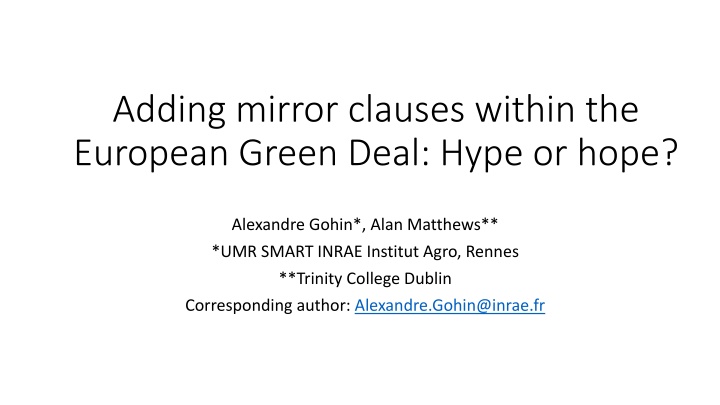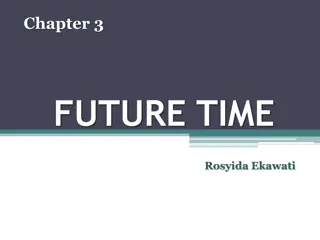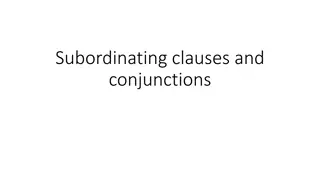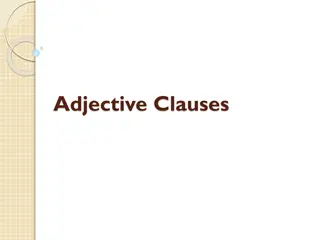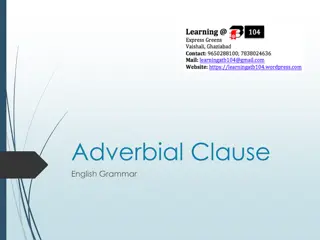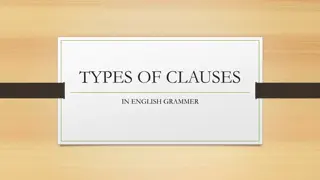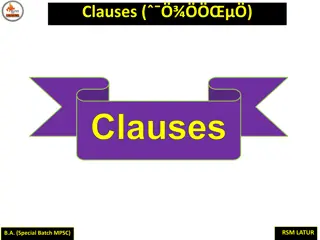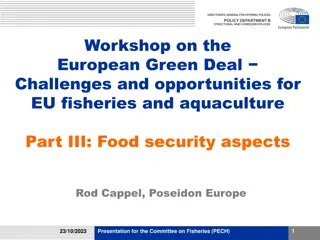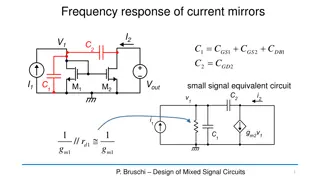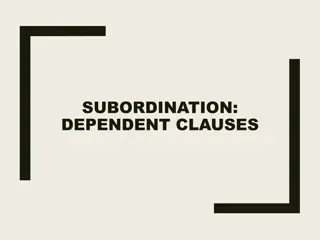Adding Mirror Clauses in European Green Deal: A Critical Assessment
European Green Deal aims for carbon neutrality, reduced chemical input, and biodiversity expansion. The notion of mirror clauses emerges as a mechanism to tie market access with environmental standards. However, challenges exist in justifying such measures, especially concerning animal welfare and environmental protection. Further assessment is crucial to determine the impacts of mirror clauses on trade dynamics.
Download Presentation

Please find below an Image/Link to download the presentation.
The content on the website is provided AS IS for your information and personal use only. It may not be sold, licensed, or shared on other websites without obtaining consent from the author.If you encounter any issues during the download, it is possible that the publisher has removed the file from their server.
You are allowed to download the files provided on this website for personal or commercial use, subject to the condition that they are used lawfully. All files are the property of their respective owners.
The content on the website is provided AS IS for your information and personal use only. It may not be sold, licensed, or shared on other websites without obtaining consent from the author.
E N D
Presentation Transcript
Adding mirror clauses within the European Green Deal: Hype or hope? Alexandre Gohin*, Alan Matthews** *UMR SMART INRAE Institut Agro, Rennes **Trinity College Dublin Corresponding author: Alexandre.Gohin@inrae.fr
1. Context The European institutions adopted in 2020 the Green Deal , with different objectives: Carbon neutrality, Reduced chemical input use in farming sectors, Increased area devoted to biodiversity, organic farming Already many qualitative and quantitative analyses, consensus on some effects (Wesseler, 2022, Gohin, 2022): EU production will decrease, compensated by higher EU net imports World prices will increase Other effects are disputed, such as: Environmental leakages in foreign countries where production may expand Evolution of the farm income (depending on price vs quantity effects)
1. Context These quantitative analyses confirm one big concern immediately raised by many stakeholders/analysts on the trade dimensions of the GD. For instance, Copa Cogeca (2021): European agriculture has sufficient resilience to adapt to the Green Deal if this policy does not act as a mechanism for environmental dumping Guyomard et al. (2020): The absence of the effective translation of EC intentions related to any border mechanism into concrete instruments can be viewed as the Achilles heel of the Green Deal initiative The idea of implementing mirror clauses quickly emerge (for instance, Baldon et al., 2021). Definition from Lamy et al. (2022): The principal aim of mirror measures is to make market access conditional to compliance with domestic environmental, animal welfare or health standards and regulations. Mirror measures call either for new provisions in bilateral free trade agreements or for measured imposed unilaterally through EU domestic laws.
1. Context Challenges with mirror measures: Lamy et al. (2022): It is more difficult to justify (mirror) measures with external effects when they concern animal welfare or environmental protection Matthews (2022): The EU should carefully assess the benefits and risks of mirror clauses on an individual basis based on the six principles and following a full impact assessment . European Commission (2022): There is some scope to extend to imported productions EU production standards provided this is one in full respect of the relevant WTO rules . Before applying production standards to imports, it is always essential to make a case by case assessment. So mirror clauses: hype or hope ? Let s turn to lessons from economic analyses
2. Review of the economic literature Mirror clauses are one of the many Non Tariff Measures (NTM) already extensively analysed (Beghin et Schweizer, 2021) To our knowledge, many ex post analyses compared to ex ante assessments (in particular using gravity econometrics ) theory explained in Matthews (2022) in a simple but robust setting One empirical analysis by Beckman (2022) with GTAP
2. Review of the economic literature Beckman et al. (2020). Economic and Food Security Impacts of Agricultural Input Reduction Under the European Union Green Deal s Farm to Fork and Biodiversity strategies. ERS Brief Number 30 The authors use the GTAP model and allow non EU countries to implement similar measures, with emphasis put on the increased number of food insecure people. As expected, no burden on EU farmers in this case. This is an extreme case of mirror measure because non EU countries are not allowed to produce according to EU new standards AND previous standards Beckman et al. (2021). Hidden obstacles to trade: the case of the EU s Ban on beef hormones. Journal of Policy Modeling, 43: 1332-1343 The authors also use the GTAP model to assess the damage to US producers of the EU NTM on hormone-free beef They also ignore that some US consumers value naturally-raised beef.
Review of the economic literature Beckman J., Ivanic M., Jelliffe J., Arita S. (2022). Adopt or not adopt? Mirror clauses and the European Green Deal. Forthcoming in Applied Economic Perspectives and Policy The authors again use the GTAP model to assess which countries may adopt the Green Deal measures They use EV as the decision criteria and compare the effect of input taxes vs an increase by 50% of import tariffs by the EU But a mirror clause can be implement if this is about production standards, not a tax policy
Our Contributions Quantitative economic analysis of mirror clauses in the context of the Green Deal: Market outcomes (price, production, consumption, trade) Welfare impacts (farm income, chemical uses, food bills) Development of an original CGE framework Endogenous number of latent vs active technologies and markets Virtual prices and flexible functional forms Application to the vegetable and fruits sectors (v&f) Intensive discussion on Maximum Residue Limits/Import Tolerance Tentative calibration using the growing literature on glyphosate ban
3. Methodology Starting point : GTAPinGAMS Computable General Equilibrium model Static, Perfect competition, profit/utility maximization Nested CES for technology and preferences (including trade specifications) Database : GTAP10A (year 2014) Regional aggregation : EU, USA, RoW Aggregation of food products similar to USDA study only the aggregate of vegetable and fruits the detailed GTAP does not provide the unknown production costs for each vegetable/fruit product No distinction of the different fertilizers/pesticides products ; No distinction of organic technology/markets gathering data on quantity, price premiums, returns across the whole food chain is cumbersome Medium term horizon Fixed capital in each sector, other factors including land perfectly mobile Fixed total investment in each region No baseline scenario
3. Farm supply modelling Standard approach: Aggregate mono-product technology specified with nested CES structure Implicit representation of the heterogeneity of farm conditions and farm production practices (e.g. Hertel et al., 1997) Possibility to adapt the calibration of the parameters of this aggregate technology to reflect the evolution of technologies (Brookes et al., 2017) However this does not recognize the different products offered. The standard implicit assumption of fixed price difference may not be relevant with new products (i.e. without perfect substitution at the demand side)
3. Farm supply modelling Our approach: Inspired by the microeconomic approach of Carpentier&Letort 2013 and already implemented in CGE by Bareille&Gohin (2020) and Gohin (2022) Multi-output technology some inputs such as accounting/insurance expenditures are not allocable Quadratic yield function Production per hectare depends on chemicals : possibility to rely on agronomic functions Land allocation across output governs by an entropic cost function Similar to the usual CET function, with land measured physically Main innovation : implementation on the v&f, assuming two technologies : A currently active technology : conv v&f (for conventional v&f technology) A latent technology : gly-free v&f (for glyphosate free technology) Introduction of virtual prices
3. Calibration of the supply side 2 0.5 ??,?. ??,? ??,? The quadratic yield function : ??,?= ??,? Of the convential v&f yield function: Due to unkown external validity of price elasticities, we follow Bremmer et al. (2021) We assume a 30% reduction of chemicals leads to a 30 reduction of conv v&f yield Of the gly-free v&f yield function: Brookes et al. (2017), Bocker et al (2020) Ye et al. (2021) on arable crops : reduced yields and substitution with other herbicides Jacquet et al. (2021) on French vineyards, Jacquet et al (2019) on French apples : between 5% and 40% of yield losses, increased costs We assume that the maximum yield is 10% lower (???? ????,?= 0.9.?????,?) and we add additional labor (4%) in fixed proportions
(Normalised) v&f yield function Initial point 1.2 1 0.8 0.6 Latent point 0.4 0.2 0 0.5 0.6 0.7 0.8 0.9 1 1.1 1.2 conventional glyphosate-free
4. Calibration of the supply side The entropic cost function leads to the following land allocation : ??. ??,? ??,? ? ??. ?? ,? ?? ,?, j=conv v&f, gly-free v&f Calibration of the a, c parameters assuming that Initially no acreage devoted to gly-free v&f due to too low profit per hectare That the share of gly-free v&f acreage reaches 20% of the total land allocated to v&f if the gly-free v&f profit per hectare equals the conv-v&f profit per hectare ??,?= ??&?,?
Acreage share of glyphosate free v&f 1.2 1 s h a r e 0.8 0.6 Latent point 0.4 0.2 0 1.05 1.07 1.09 1.11 1.13 1.15 1.17 1.19 Relative price of gly-free v&f % conv v&f
4. Final demand and trade modelling Standard approach: Nested structure with CES functions for the arbitrage between imported and domestic goods, CES-LES-CDE-AIDADS for the arbitrage between composite goods Globally regular and partially flexible in price/income effects But it does not allow latent demands Our approach: The NQES for trade and preferences (already implemented for trade by Gohin and Laborde, 2006) Globally regular and flexible It allows latent demands (virtual prices) But intensive in parameters. Some separability assumptions. Assumptons of perfect substitution for the trade of gly-free v&f
4. Calibration of the trade side From Fontagn et al. (2022), Armington substitution elasticity between all sources = 7 for conv v&f. We replace the CES by the NQES, thus maintaining homotheticy with respect to total demand (possibility to introduce quasi homothetic import demand functions) Assumption of perfect substitution across sources for gly-free v&f Unitary trade costs are equal with those of conv v&f We assume that only the EU and USA are able produce/consume gly-free v&f. Introduction of NQES to be contemplated with more virtual prices when more countries will be considered
4. Calibration of the final demand First separability of v&f with other foods and other goods/services (both are aggregated with a Cobb Douglas, not a big empirical issue as price effets on other goods are limited). Large litterature assessing WTP by consumers for reduced exposure to pesticide (Florax et al., 2005 ; Ali et al., 2021): evidence of price premiums. To calibrate NQES parameters, we assume : Initial virtual prices of gly-free v&f = price of conv v&f excluding VAT. We assume cross price elasticities and income elasticities. For the gly-free demand, we adopt the elasticities of the conv v&f and a high substitution elasticity between the two types of v&f (elasticity of conv v&f demand with respect to price of gly-free v&f = 25)
4. Simulation of the EU conv v&f demand function (% of initial consumption) Price of Gly-free v&f 0.9 0.95 1 1.05 1.10 Price of the conv v&f 0.9 100.3 106.5 106.5 106.5 106.5 0.95 0 100.1 103.3 103.3 103.3 1 0 0 100 100 100 1.05 0 0 0 96.7 96.7 1.10 0 0 0 0 93.5 The latent point The initial point
4. Simulation of the EU gly-free v&f demand function (% of initial consumption of conv v&f) Price of Gly-free v&f 0.9 0.95 1 1.05 1.10 Price of the conv v&f 0.9 6.4 0 0 0 0 0.95 106.6 3.2 0 0 0 1 106.6 103.2 0 0 0 1.05 106.6 103.2 99.9 0 0 1.10 106.6 103.2 99.9 96.5 0 The latent point The initial point
5. Scenarios 1. the Green Deal : an endogenous input tax to reduce chemical use by 35% and banning glyphosate use in Europe; conv v&f can still be consumed and imported 2. the mirror clause : 1 + conv v&f can not be consumed/imported. The European input tax adjusts to cope with the rebound effect
Markets impacts of the Green Deal scenario Gly free v&f (% of initial conv v&f) Conv v&f (changes in %) Exports to EU Exports to Row Final Demand Final Demand Price Supply Price Supply USA 1.4 3.1 97.5 1.4 -0.8 9.4 EU - -100 - -100 -76.5 12.6a -40.8b -32.1c RoW 0.9 2.8 102.2 - -0.4
Welfare impacts of the Green Deal scenario Chemical use in v&f (%) 3.1 Chemical use farms (%) 0.5 v&f income (bi $ and %) Farm income (bi $ and %) 2.7 (1.8) v&f bill (bi $ and %) Food bill (bi $ and %) in USA 2.1 (5.9) 0.2 (0.4) 0.4 (0+) EU -35.2 -7.1 -24.6 (-48.6) -27.6 (-13.1) 1.6 (2.4) -0.9 (-0.1) RoW 2.6 0.9 28.7 (3.8) 33.1 (1.7) 4.8 (0.8) 10.0 (0.2) Total 1.5 0.5
Market impacts of the Mirror Clause Scenario Gly free v&f (% of initial conv v&f) Conv v&f (changes in %) Exports to EU Exports to Row Final Demand Final Demand Price Supply Price Supply USA 8.6 -46.6 -100 -74.6 -3.1 26.1 -40.5 EU - -100 -100 -100 29.3 -39.9 -19.9 RoW 0.6 1.5 -100 -0.3
Welfare impacts of the Mirror Clause scenario Chemical use in v&f (%) 19.6 Chemical use farms (%) 2.4 v&f income (bi $ and %) 14.7 Farm income (bi $ and %) 16.4 v&f bill (bi $ and %) 0.8 Food bill (bi $ and %) 5.5 in USA EU -35.1 -7.1 -23.9 -26.6 2.5 9.2 RoW 1.5 0.6 17.2 21.6 3.2 8.4 Total 1.1 0.4
5. Discussion On the methodology with zero : reproducing Beckman 1. the Green Deal : an endogenous input tax to reduce chemical use by 35% and banning glyphosate use in Europe; conv v&f can still be consumed and imported 2. the mirror clause : 1 + input taxes in the US to reduce chemical use + EU prohibitive tariff on RoW exports. conv v&f can not be consumed/imported. The European input tax adjusts to cope with the rebound effect
Markets impacts of the Green Deal scenario with GTAP Gly free v&f (% of initial conv v&f) Conv v&f (changes in %) Exports to EU Exports to Row Final Demand Final Demand Price Supply Price Supply USA 0.8 2.0 61.7 0.5 -0.5 EU 7.4 -31.4 - -73.2 -3.1 RoW 0.6 1.7 66.6 - -0.3
Welfare impacts of the Green Deal scenario with GTAP Chemical use in v&f (%) Chemical use farms (%) v&f income (bi $ and %) Farm income (bi $ and %) v&f bill (bi $ and %) Food bill (bi $ and %) in USA 2.0 0.3 1.4 1.7 0.1 0.2 EU -33.3 -6.7 -22.8 -25.5 0.9 -0.9 RoW 1.7 0.6 19.3 21.9 3.0 6.5 Total 0.7 0.2
Market impacts of the Mirror Clause Scenario with GTAP Gly free v&f (% of initial conv v&f) Conv v&f (changes in %) Exports to EU Exports to Row Final Demand Final Demand Price Supply Price Supply USA 11.1 -32.9 432.9 -95.2 -4.3 EU 69.7 -28.7 -100 -37.0 RoW 0.7 2.2 -100 -0.4
Welfare impacts of the Mirror Clause scenario with GTAP Chemical use in v&f (%) Chemical use farms (%) v&f income (bi $ and %) Farm income (bi $ and %) v&f bill (bi $ and %) Food bill (bi $ and %) in USA -34.2 -4.0 -18.7 -20.4 0.8 -0.1 EU -32.8 -7.2 -20.2 -22.4 -0.2 29.1 RoW 2.2 0.7 24.4 26.1 4.3 9.7 Total -0.2 -0.1
6. Concluding comments Mirror clauses within the Green Deal : hype or hope ? Starting from the benchmark GTAP framework, we develop an original model, tailored to the issue of MRL of pesticides within vegetable and fruits products We simulate ex ante the impacts of glyphosate ban in the EU, allowing EU and USA to implement alternative technologies As expected, we find that EU farmers may not benefit from mirror clauses if foreign countries are better able to adopt new technologies while households pay higher food bills We also find that world chemical uses by farmers may not decrease, due to leakage/substitution effects Our original framework is useful for ex ante, macro-economic assessment of potential regulations on technologies/production/demand/trade flows
WP2 Emerging trade flows Why do we trade and by how much? First because there are frontiers (and customs data to analyse) Many dimensions already analysed/quantified : Quality / preferences Spatial / transport costs Timing of production/consumption / storage costs Firm heterogeneity/ scale-network effects Stochastic effects Policy The product (and the relevant technology) does not already exist !
Romer P. (1994). New goods, old theory, and the welfare costs of trade restrictions. Journal of Development Economics, 43, 5-38. The typical economic model implicitly assumes that the set of goods in an economy never changes. As a result, the predicted efficiency loss from a tariff is small, on the order of the square of the tariff rate. If we loosen this assumption and assume that international trade can bring new goods into an economy, the fraction of national income lost when a tariff is imposed can be much larger, as much as two times the tariff rate. Much of this paper is devoted to explaining why this seemingly small change in the assumptions of a model can have such important positive and normative implications. The paper also asks why the implications of new goods have not more extensively been explored, especially given that the basic economic issues were identified 150 years ago. The mathematical difficulty of modeling new goods has no doubt been part of the problem. An equally, if not more important stumbling block has been the deep philosophical resistance that humans feel toward the unavoidable logical consequence of assuming that genuinely new things can happen and could have happened at every date in the past. We are forced to admit that the world as we know it is the result of a long string of chance outcomes.
